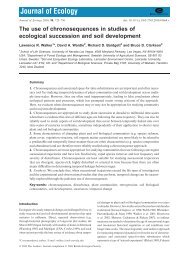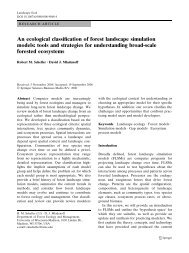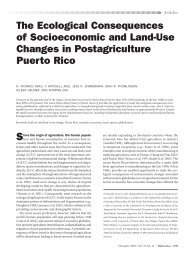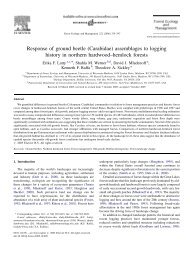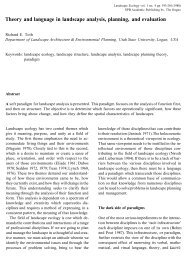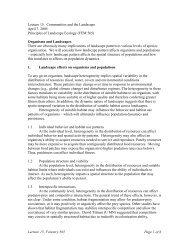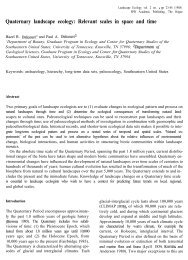Improving the formulation of tree growth and succession in a ...
Improving the formulation of tree growth and succession in a ...
Improving the formulation of tree growth and succession in a ...
Create successful ePaper yourself
Turn your PDF publications into a flip-book with our unique Google optimized e-Paper software.
S. Schumacher et al. / Ecological Modell<strong>in</strong>g 180 (2004) 175–194 187<br />
Fig. 6. Diameter (diameter at breast height, DBH) distribution dur<strong>in</strong>g st<strong>and</strong> development after w<strong>in</strong>d disturbance (1750–1850 m a.s.l.).<br />
diameter classes (Fig. 6f). The pattern <strong>of</strong> stem numbers<br />
over time was similar for all st<strong>and</strong>s up to 2050 m a.s.l.<br />
Above this altitude, stem number fluctuations ceased,<br />
<strong>and</strong> stem numbers were generally higher than those at<br />
<strong>the</strong> equilibrium phase <strong>in</strong> st<strong>and</strong>s at lower elevations.<br />
4.2. Model application<br />
The sensitivity <strong>of</strong> <strong>the</strong> model to future climate scenarios<br />
was <strong>in</strong>vestigated by compar<strong>in</strong>g total aboveground<br />
biomass, <strong>tree</strong> species composition <strong>and</strong> <strong>the</strong> fraction <strong>of</strong><br />
st<strong>and</strong> structure types aggregated over <strong>the</strong> entire forested<br />
area (exclud<strong>in</strong>g avalanche tracks) (Fig. 8).<br />
Under <strong>the</strong> ‘current’ scenario, total biomass yielded<br />
an average <strong>of</strong> 185 t/ha; under <strong>the</strong> ‘moderate’ future scenario,<br />
somewhat higher values were achieved, while <strong>the</strong><br />
‘extreme’ scenario resulted <strong>in</strong> less biomass (ca. −10%)<br />
than <strong>the</strong> ‘current’ scenario (Fig. 8a).<br />
Also, <strong>the</strong> three scenarios resulted <strong>in</strong> different<br />
average species compositions (Fig. 8a). While <strong>the</strong>



